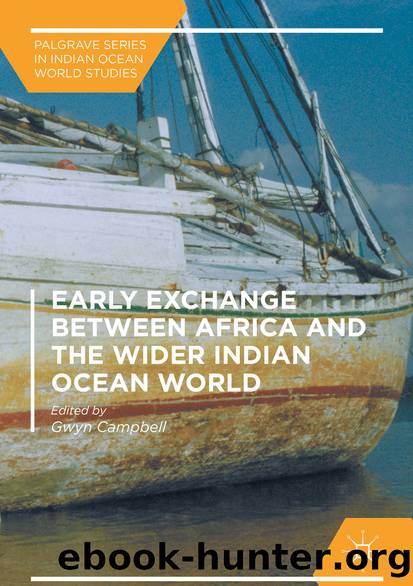Early Exchange between Africa and the Wider Indian Ocean World by Gwyn Campbell

Author:Gwyn Campbell
Language: eng
Format: epub
Publisher: Springer International Publishing, Cham
Southern African Beads Compared to v-Na-Ca Zanzibari Beads
Although chemically the glass used for Zhizo beads and v-Na-Ca beads from Zanzibar is similar, morphologically there are a number of differences. Zhizo beads are made from drawn tube segments that are normally not reheated, so they are left with sharply cut ends. By contrast, most of the Zanzibari examples have been reheated (most on a flat surface), so have rounded or smoothed ends. Also, Zhizo beads appear in only four coloursâcobalt blue, yellow and more rarely blue-green or greenâwhile the Unguja Ukuu beads include brick-red and colourless/white glass as well. Additionally, decorated, segmented, pinched and wound beads, as found in the Unguja Ukuu assemblage, are absent from the Zhizo series. Although two of the Unguja Ukuu blue-green beads look like possible Zhizo candidates, close inspection shows that they have been reheated on a flat surface so fail to qualify.
It appears possible that the v-Na-Ca beads from Zanzibar were made in Southeast Asia, perhaps Thailand, and that they were traded through Sri Lanka. Zhizo beads, on the other hand, are more likely to have been made in the Persian Gulf region. Evidence for this begins with Al-Masâudi, who in 916 CE visited Qanbalu on a return voyage from China and India. He reported that Sofala (which then referred to the coast of Mozambique, not to a single port) was the âfurthest limit of the land and the end of the voyages made from Oman and Siraf on the sea of Zanjâ (Freeman-Grenville 1962: 14â16). Al-Masâudi states that ships sailed directly from the Gulf region to Qanbalu before heading for Sofala. If Qanbalu was indeed on Pemba Island, as is widely believed (Trimingham 1975a: 122, 135; Chittick 1977: 192; Hourani 1995: 148; Horton and Middleton 2000: 66), this could help explain the presence of Zhizo beads at Tumbe and their absence at other sites on the east African coast. Moira Tampoe (1989: 102) also cites al-Masâudi as saying that a growth in demand for luxury goods at the Buyid court in Shiraz encouraged Sirafi traders to undertake an increasing number of voyages to Sofala. Finally, al-Masâudi states that, in addition to enormous ivory tusks, Sofala provided gold. This is the first mention of trade in the precious metal from the south and could partially account for the great Persian Gulf interest in trade with the region.
Because only one type of bead at a time was being traded into southern Africa (and these beads are rare in East Africa), it is reasonable to assume that they all originated from the same region, if not from the same workshop or series of workshops. Al-Masâudi indicates that merchant ships from Oman and Siraf sailed directly to Sofala, and it is believed that the glass used to make the Chibuene and Zhizo series beads was made in the Iraq/Iran region. Thus, although this type of glass was traded widely as cullet, the case here seems to favour a regional production for the beads since the ships carrying them appear to have come from the same region that produced the glass.
Download
This site does not store any files on its server. We only index and link to content provided by other sites. Please contact the content providers to delete copyright contents if any and email us, we'll remove relevant links or contents immediately.
| Africa | Americas |
| Arctic & Antarctica | Asia |
| Australia & Oceania | Europe |
| Middle East | Russia |
| United States | World |
| Ancient Civilizations | Military |
| Historical Study & Educational Resources |
Machine Learning at Scale with H2O by Gregory Keys | David Whiting(4176)
Never by Ken Follett(3788)
Fairy Tale by Stephen King(3219)
The Man Who Died Twice by Richard Osman(2996)
Oathbringer (The Stormlight Archive, Book 3) by Brandon Sanderson(2875)
Will by Will Smith(2791)
Rationality by Steven Pinker(2291)
The Dark Hours by Michael Connelly(2243)
Can't Hurt Me: Master Your Mind and Defy the Odds - Clean Edition by David Goggins(2225)
The Dawn of Everything: A New History of Humanity by David Graeber & David Wengrow(2122)
Friends, Lovers, and the Big Terrible Thing by Matthew Perry(2117)
Principles for Dealing With the Changing World Order: Why Nations Succeed and Fail by Ray Dalio(1971)
HBR's 10 Must Reads 2022 by Harvard Business Review(1776)
A Short History of War by Jeremy Black(1759)
Go Tell the Bees That I Am Gone by Diana Gabaldon(1687)
515945210 by Unknown(1599)
A Game of Thrones (The Illustrated Edition) by George R. R. Martin(1588)
Kingdom of Ash by Maas Sarah J(1522)
443319537 by Unknown(1467)
